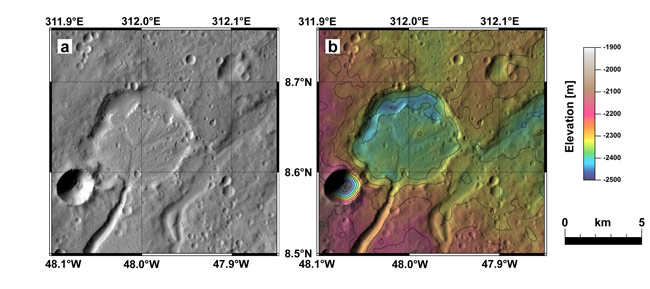Study Suggests It Rained on Ancient Mars

Scientists studying the Martian landscape said yes, a riverran through it — and not just one. The ancient red planet also seems to haveexperienced rain, they say.
The rivers may have cut the deep valleys in the Martianhighlands near the equator, and also left calling cards elsewhere. Three Marsspacecraft spotted signs of fan-shaped river deltas insideancient craters which some valleys clearly flow into.
"We can see layered sediments where these valleys openinto impact craters," said Ernst Hauber, a geologist at the DLR (Germanspace agency) Institute of Planetary Research in Berlin-Adlershof. "Theshape of certain sediments is typical for deltas formed in standingwater."
Rivers carry sediment downstream until the currents becometoo weak and let the material fall to the river bottom. The flow almost dropsto zero at places where rivers empty into a larger body of water, such as alake-filled crater.
Hauber and other researchers focused on possible ancientriver valleys crisscrossing the Xanthe Terra highland region. They examinedcrater images taken by the European Mars Express, NASA's Mars Global Surveyor,and NASA's Mars Reconnaissance Orbiter.
One small 3-mile (5-km) crater contains possible proof inthe form of a fan-shaped delta, where the Nanedi river flows into the craterfrom the south. Sediment has almost completely filled the crater up to 164 feet(50 meters) deep in an area covering slightly less than 9 square miles (23 sqkm).
Researchers also counted the number of craters to roughlydetermine the age of the planetary surface in the area.? Their crater countrevealed that water flowed through the valleys sometime between 3.8 and 4billion years ago. Additional work by Maarten Kleinhans, a geologist at theUniversity of Utrecht in the Netherlands, showed that the crater sedimentdeposits formed in no less than a few hundred thousand years.
Breaking space news, the latest updates on rocket launches, skywatching events and more!
The valleys flowing into and out of the craters allowresearchers to be "fairly certain that there were lakes on Mars,"Hauber noted.
An ongoing debate is whether rain and snowmelt orgroundwater may have played a bigger role in creating the valleys. The mostrecent findings presented at the European Planetary Science Congress inMuenster, Germany provide more evidence for the former.
"Our findings also point in this direction and we areconvinced that both processes have played an important role in XantheTerra," Hauber said.
Other research has suggested that water flowed in the plainsaround the Valles Marineris region until even morerecently, around 3.7 billion to 3 billion years ago. But no evidence so farhas shown flowing surface water still exists on Mars.
- Video - A Wet Modern Mars?
- Images - Visualizations of Mars
- Zoom In - Water on Mars?

Space.com is the premier source of space exploration, innovation and astronomy news, chronicling (and celebrating) humanity's ongoing expansion across the final frontier. Originally founded in 1999, Space.com is, and always has been, the passion of writers and editors who are space fans and also trained journalists. Our current news team consists of Editor-in-Chief Tariq Malik; Editor Hanneke Weitering, Senior Space Writer Mike Wall; Senior Writer Meghan Bartels; Senior Writer Chelsea Gohd, Senior Writer Tereza Pultarova and Staff Writer Alexander Cox, focusing on e-commerce. Senior Producer Steve Spaleta oversees our space videos, with Diana Whitcroft as our Social Media Editor.
